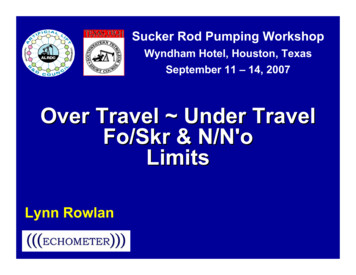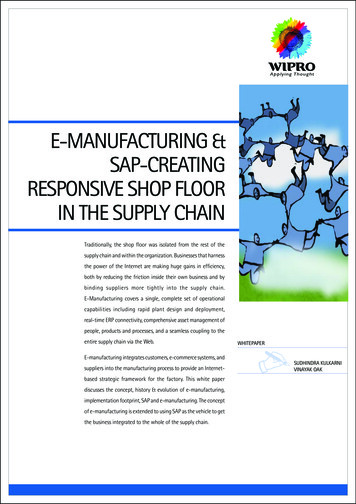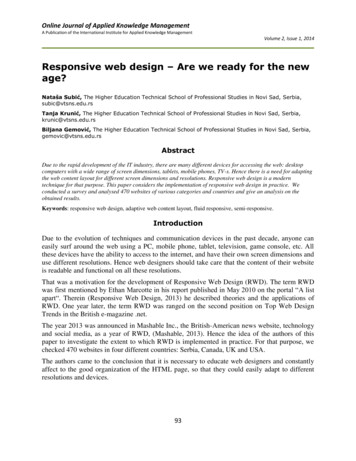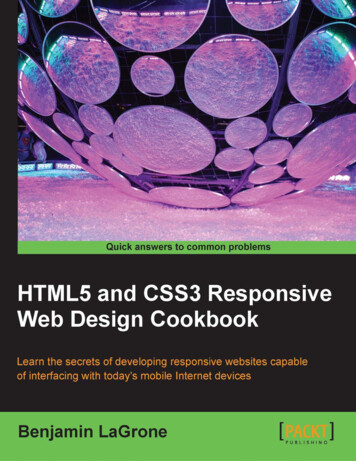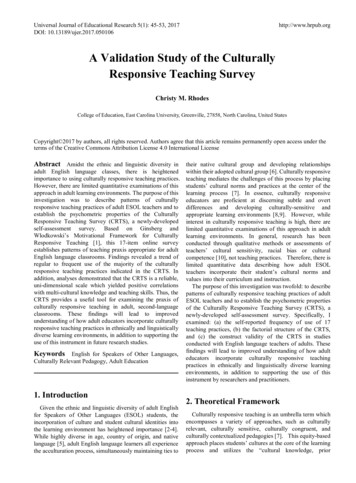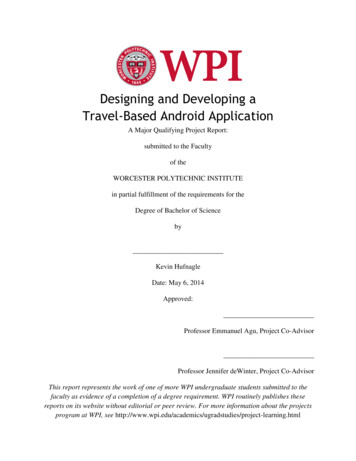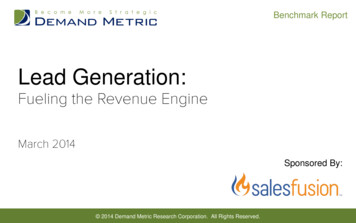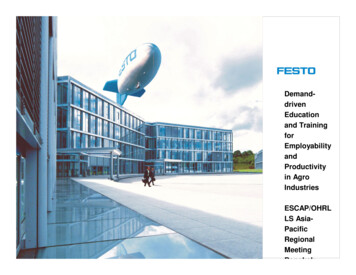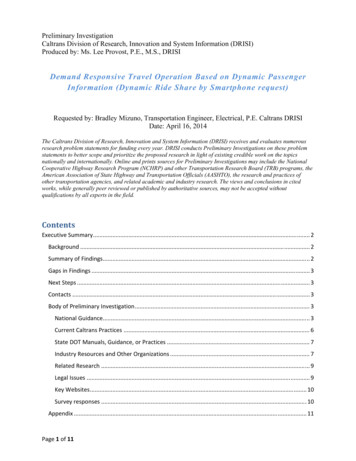
Transcription
Preliminary InvestigationCaltrans Division of Research, Innovation and System Information (DRISI)Produced by: Ms. Lee Provost, P.E., M.S., DRISIDemand Responsive Travel Operation Based on Dynamic PassengerInformation (Dynamic Ride Share by Smartphone request)Requested by: Bradley Mizuno, Transportation Engineer, Electrical, P.E. Caltrans DRISIDate: April 16, 2014The Caltrans Division of Research, Innovation and System Information (DRISI) receives and evaluates numerousresearch problem statements for funding every year. DRISI conducts Preliminary Investigations on these problemstatements to better scope and prioritize the proposed research in light of existing credible work on the topicsnationally and internationally. Online and prints sources for Preliminary Investigations may include the NationalCooperative Highway Research Program (NCHRP) and other Transportation Research Board (TRB) programs, theAmerican Association of State Highway and Transportation Officials (AASHTO), the research and practices ofother transportation agencies, and related academic and industry research. The views and conclusions in citedworks, while generally peer reviewed or published by authoritative sources, may not be accepted withoutqualifications by all experts in the field.ContentsExecutive Summary . 2Background . 2Summary of Findings. 2Gaps in Findings . 3Next Steps . 3Contacts . 3Body of Preliminary Investigation . 3National Guidance. 3Current Caltrans Practices . 6State DOT Manuals, Guidance, or Practices . 7Industry Resources and Other Organizations . 7Related Research . 9Legal Issues . 9Key Websites . 10Survey responses . 10Appendix . 11Page 1 of 11
Executive SummaryBackgroundCurrently, there is real-time information available to transit operations and travelers via theinternet that can be accessed on a laptop, Smartphone (android cell phone) or similar. Thistechnology provides notifications of travel delays, arrivals, alternatives and other travelinformation, which can be helpful in making travel decisions for fixed routes and times. Incontrast, what if a traveler put in a request via their Smartphone or laptop to have transit fit theirschedule? GPS tracking is already in use for buses and Smartphones, but the idea is to have ademand-type ride based on a cell phone request. This preliminary investigation (PI) researchrequest is for Dynamic Ride Share(D Ride), allowing the location, messaging and computingcapabilities of Smartphones to share information between drivers and riders in real time, in orderto make transit more convenient toward an individual traveler’s schedule. This PI will determineif there anyone in the United States (U.S.) putting these D Ride concepts to use or testing aprototype.Summary of FindingsToday, app-based transportation alternatives such as car and ride share programs thrive inSacramento, Ca. “UBER” offers a low cost ride share service, “Zipcar” offers a fleet of localsmall car rentals and “Lyft” offer community members an option for ride-sharing alternative taxicab. (“Car and Ride Share Programs in Sacramento” Capitol Public Radio November 7, 2013.)The core of this PI is more than just a singular taxi-cab transportation alternative. This PIresearch is geared toward a more transit-orientated D Ride, to make transit more convenienttoward a particular individual traveler’s schedule that is Smartphone based.This PI discovered that there is a prototype being developed and tested for Integrated DynamicTransit Operations (IDTO) by the U.S. Department of Transportation (DOT), Federal TransitAdministration (FTA). The lead researcher is Ronald Boenau, Office of Research Managementin Washington, DC. The prototypes are being tested in Orlando, Florida and Columbus, Ohiothis year (2014). The full report is listed in the appendix of this document. However, there is nocurrent use of this type of IDTO being used in the U.S.Topics may include: National Guidance Current Caltrans Practices State DOT Policies and Practice Industry Resources and Other Organizations Related Research Legal Issues Web Resources Research in ProgressPage 2 of 11
Gaps in FindingsNoneNext StepsA research project may be requested to fit California’s transit needs and a follow up to see theUS DOT FTA’s project findings at the end of this year (2014).ContactsRonald E. Boenau, P.E., Senior Transportation Systems Manager, Special Operations. Office ofResearch Management, TRI-30. Federal Transit Administration, U.S. DOT, 1200 New JerseyAvenue, S.E. Washington, DC. 20590. (202) 366-0195 Ronald.Boenau@dot.gov. Please referto the research survey responses found below in this PI.Body of Preliminary InvestigationNational GuidanceIntegrated Dynamic Transit Operations (IDTO) Prototype DevelopmentRonald E.Boenau, P.E, Federal Transit Administration (FTA), Philadelphia, PA. September 2013Power point for the USDOT Connected Vehicle Research project, ITE Mid-Atlantic Sectionhttp://www.masite.org/PDF/Past/2013 09 20 02G Boenau.pdfPrototypes are being tested in Orlando, Florida and Columbus, Ohio in Winter and Spring 2014,with results expected by Fall 2014.Connection Protection: to increase likelihood of making successful transfers, particularly multimodal or multi-agency.Dynamic Transit Operations: –Traveler - accesses real-time information on travel options, costsand arrival times. Agency - extends demand / response services to support dynamic routing andscheduling and add/remove vehicles from service based on traffic conditions, vehicle capacity,ridership, origin-destination, etc.Dynamic Ridesharing: leverages the positioning, messaging, and computing capabilities ofSmartphones to allow drivers and riders exchange information in real time.An email was sent on 4-15-14 to Mr. Ronald Boenau, FTA to ask if he was aware of anyone elsein the U.S. who is putting his concepts or testing the technology now. Ronald.Boenau@dot.govRITA: Assessment of Relevant Prior and Ongoing Research for the Concept Developmentand Needs Identification for Integrated Dynamic Transit Operations November 2011http://www.its.dot.gov/ FHWA-JPO-12-0823-IDTO Assessmentof Ongoing ResearchPage 3 of 11Entire report is available. Click on the icon.
This report was a response e mail from Mr. Ronald Boenau, FTA on 4-16-14. He said he’s notaware of anyone else conducting testing like he’s doing in IDTO, but he cc’d his contractor TomTimcho of Battelle, who might have additional insights. He attached the above initial researchreport.Report Abstract: In support of USDOT’s Intelligent Transportation Systems’ (ITS) MobilityProgram, the Dynamic Mobility Applications (DMA) program seeks to create applications thatfully leverage frequently collected and rapidly disseminated multi-source data gathered fromconnected travelers, vehicles and infrastructure to increase efficiency and improve individualmobility while reducing negative environmental impacts and safety risks. There are threeIntegrated Dynamic Transit Operations (IDTO) applications: Connection Protection (TCONNECT); Dynamic Transit Operations (T-DISP); and Dynamic Ridesharing (D-RIDE). TheT-CONNECT application will provide transit users and riders the means to ensure successfultransit transfers. T-DISP will allow travelers to make real-time trip requests through personalmobile devices. D-RIDE will identify and accept potential ridesharing opportunities along agiven travel route.This report provides a review of relevant past and ongoing research and also provides adefinition and vision for the IDTO applications, currently available technologies, methodologies,and existing practices. Also described is a summary and synthesis of findings, potential impactsof IDTO implementation from an institutional, operational and technical perspective, and nextsteps. This research forms the basis for the current state definition within the Concept ofOperations (ConOps).Real Time Bus Arrival Info Systems TCRP Synthesis 48http://onlinepubs.trb.org/onlinepubs/tcrp/tcrp syn 48.pdfThis synthesis report will be of interest to transit staff concerned with implementing real-timebus arrival information systems at their agencies. Information on relevant technical capabilities,agency experience, cost, and bus rider reactions to these information systems was documented.The report describes the state of the practice, including both U.S. and international experience. Itdocuments survey information, a review of the relevant literature, as well as interviews with keypersonnel at agencies that have, or are in the process of, implementing these systems.Transit Connected Vehicle Research Program- Enhances Mobility ChoicesIntelligent Transportation Systems Joint Program OfficeRITA US DOT Research Innovative Technology ransit connectedvehicle.htmThe overarching goal of the Transit Connected Vehicle for Mobility program is to improvepublic transportation by increasing transit productivity, efficiency, and accessibility; mitigatingcongestion in an integrated transportation environment; and providing travelers with bettertransportation information and transit services. Transit-oriented connected vehicle mobilityapplications support dynamic system operations and management, enable a convenient andquality travel experience, and provide an information-rich environment to meet the needs oftravelers and system operators across all modes.The following three mobility applications have been selected as high-priority applications andare collectively identified as the Integrated Dynamic Transit Operations (IDTO) “bundle”:Page 4 of 11
Connection Protection (T-CONNECT): Enables public transportation providers and travelers tocommunicate to improve the probability of successful transit transfers.Dynamic Transit Operations (T-DISP): Advances the concept of demand-responsivetransportation services utilizing the global positioning system (GPS) and mapping capabilities ofpersonal mobile devices to enable a traveler to input a desired destination and time of departuretagged with their current location when requesting transit service.Dynamic Ridesharing (D-RIDE): Makes use of in-vehicle and hand-held devices to allowdynamic ride-matching, thereby reducing congestion, pollution, and travel costs to the individualwith a low initial investment.A description of all the high-priority Connected Vehicle for Mobility applications and theprocess through which they were selected and grouped can be found at: www.its.dot.gov/press/2011/mobility app.htm.Connected Vehicle Reference Implementation Architecture (CVIRA)RITA US Dept of Transportation, Research & Innovation Technology AdministrationDraft ns/app77.htmlThe Dynamic Transit Operations application allows travelers to request trips and obtainitineraries using a handheld mobile device (or personal computer). The trips and itinerarieswould cover multiple transportation services (public transportation modes, private transportationservices, shared-ride, walking and biking). This application builds on existing technologysystems such as computer-aided dispatch/ automated vehicle location (CAD/AVL) systems andautomated scheduling software, providing a coordination function within and between transitproviders that would dynamically schedule and dispatch or modify the route of an in-servicevehicle by matching compatible trips together. – Related resources: Integrated Dynamic TransitOperations (IDTO) ConOps Draft 5/11/12Active Transportation and Demand Management (ATDM) Program 3002/fhwahop13002.pdfATDM is the dynamic management, control, and influence of travel demand and traffic flow ontransportation facilities. Through the use of available tools and assets, traffic flow is managedand traveler behavior is influenced in real-time to achieve operational objectives, such aspreventing or delaying breakdown conditions, improving safety,
systems such as computer-aided dispatch/ automated vehicle location (CAD/AVL) systems and automated scheduling software, providing a coordination function within and between transit providers that would dynamically schedule and dispatch or modify the route of an in-service vehicle by matching compatible trips together. – Related resources: Integrated Dynamic Transit
